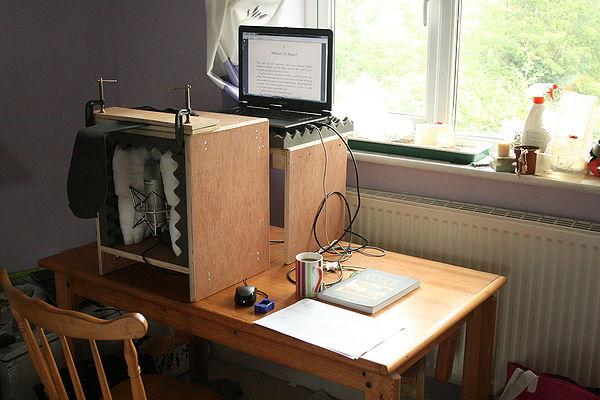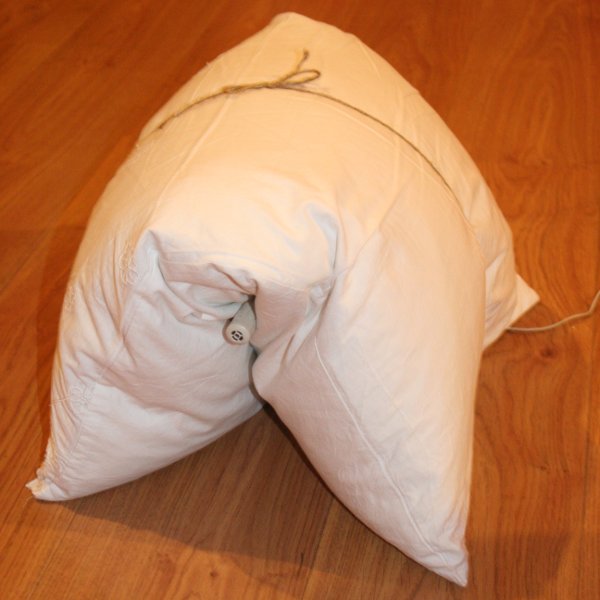Make a Portable Vocal Booth: Difference between revisions
No edit summary |
pillow booth added |
||
| Line 30: | Line 30: | ||
You can hear the difference that a porta-booth makes to the sound in this [http://www.archive.org/download/SoundSamplesEtc/bedroom_and_booth.mp3 audio_clip] [http://www.archive.org/details/SoundSamplesEtc bedroom_and_booth]. The recording was made in the room pictured, the same text was read into the same microphone in the same location in the room. The clips recorded without the booth are first, and the clips recorded with the booth are second. |
You can hear the difference that a porta-booth makes to the sound in this [http://www.archive.org/download/SoundSamplesEtc/bedroom_and_booth.mp3 audio_clip] [http://www.archive.org/details/SoundSamplesEtc bedroom_and_booth]. The recording was made in the room pictured, the same text was read into the same microphone in the same location in the room. The clips recorded without the booth are first, and the clips recorded with the booth are second. |
||
[[File:Pillow_booth.jpg|600px|thumb|left|a booth made from a feather pillow]] Finally, here is a zero-cost portable booth idea! It doesn't work quite as well as the booth filled with acoustic foam, but it is pretty good. It is made by folding a feather pillow in half and tying a piece of string around the middle to keep it folded. A wand microphone (a Logitech in this case) can then be pushed through the middle of the pillow. Try to keep just the front surface of the microphone exposed (the microphone in the picture is poking a bit too far out). With an omnidirectional microphone like the Logitech most of the room echo enters by the side or back, but the voice enters through the front, so the pillow does a good job of cutting aout a lot of the unwanted room echo. |
|||
Revision as of 21:23, 13 March 2012
Many Librivox readers want to improve the technical quality of their recordings. Although buying a better microphone can often make a dramatic improvement to the recorded voice tone, there is no point in buying an expensive microphone without looking at the space you record in as well. A recording studio spends a great deal more time, effort and money on the recording space than it does on microphones. But you don't have to spend a lot: a Librivox reader can often make dramatic improvements to the quality of the recording space for less than the cost of a new microphone. In fact many Librivox readers have told me that the little money they spent on acoustic foam made more difference to their sound quality than anything else, including new microphones costing five times as much. This article gathers together ideas from several Librivox readers who have experimented with cheap ways to improve speech recording at home. The article describes a low cost enclosure that limits reflected sound from entering the microphone.
It is worth starting by pointing out that the special walls, ceiling, floor and doors in a recording studio do two entirely separate things: Sound Isolation and Sound Treatment. Sound Isolation stops outside noises (such as traffic, children, animals etc.) from getting through to the microphone and being recorded along with your voice. Sound isolation is difficult and often expensive to achieve, and is not covered in this article. Sound Treatment alters the nature of the sound within the studio by absorbing unwanted sound reflections before they can get back to the microphone. For audiobooks we want to get rid of as much reflected sound as we can.
You can spend a lot of money and buy boxes and boxes of acoustic foam tiles, and then glue them all over the walls and ceiling in a spare room. If the foam is thick enough then you will certainly reduce the sound reflection within the room and the recordings will be improved. But because you aren't recording music you don't need a studio that big, and the smaller your studio the less it costs in materials.
In fact a number of years ago voice over artist Harlan Hogan realised that you don't even have to eliminate the sound reflections within a room - you only have to stop them entering the microphone. Rather than sticking acoustic foam tiles onto the walls of a room to make a vocal booth you can stand in, you can stick acoustic foam tiles to the inside of a box just large enough to hold your microphone. With the microphone well back into the box no sound can enter from the sides, back or top, and the reader's head blocks most of the reflected sound entering the front of the microphone. Harlan Hogan generously published an online article describing how to make a "Porta-Booth". You can see how simple the booth can be!
One big problem everyone runs into when making the porta-booth is getting hold of small quantities of acoustic foam. If you buy Auralex foam it comes in boxes containing twelve 2 foot by 4 foot tiles. You probably only want about four 12" tiles for your box! You might be able to get around this by sharing a box with other readers, or by contacting your local music store to see if they would be willing to split a box and sell you individual tiles. However, if you search on eBay you can usually find suppliers willing to sell individual or small numbers of acoustic tiles. Often these will not be Auralex, but from a different manufacturer. To make my booth I used 40mm thick "eggbox" foam from Advanced Acoustics in Mansfield, Nottinghamshire, UK. The tiles were good, but I did need to pack the centre of the box with extra padding to make the booth work really well. (Please update the wiki to include your experience using other acoustic foam tiles).
I'm not going to draw up any plans for an LV porta-booth (unless there is enough interest), because the size of the box depends on the size and shape of your microphone. You can construct a box out of pretty much anything you like. One reader made a cardboard enclosure with foam held onto the inside with spray-glue so he could fold it up and store it away between sessions. I decided to make mine out of plywood.
Before you start to cut the tiles plan how they are going to fit inside the box. You can glue the tiles in, but if you are careful you can get the tiles to hold each other in place through their springiness.
If you have access to a hot wire cutter at your local high school technology department, then that will give you a beautifully neat cut. Don't try to cut the foam with scissors or a craft knife as the foam pushes away from the blade and you will get a lumpy cut surface. I found that an ordinary serrated bread knife works best. Mark out your cut line on the reverse of the tile (the flat side) and put the tile onto a table so the cut line just overhangs the edge of the table. Gently saw along the marked line using as little pressure as possible. If you search on YouTube you can find instruction videos showing how to make a porta-booth.
I have received reports that the spray glue sold to hold down carpets works well with some acoustic foams. I did not need to glue the foam into place in my box, so I cannot confirm this.
Although not the main reason for building one, a porta-booth can help reduce fan noise if you record directly into a laptop. Because the booth limits sound entering the back of the microphone you can reduce the amount of fan noise entering the microphone by placing your laptop behind the booth. This means that the fan noise has to reflect off the walls and ceiling before it can enter the microphone, greatly reducing the level of noise.
Here is my recording set-up.

The large box is lined with foam tiles and the microphone is placed as far back as it will go. I found that I needed a bit more absorbent material than just the tiles, so I packed in a length of polyester wadding cut from the inside of an old duvet. The microphone is a Samson C01U in a desktop shock mount.
Behind the booth itself is a laptop stand so I can read the text directly from the screen. The laptop stands on another slab of acoustic foam to limit transmission of fan noise through the woodwork of the stand. When not in use the laptop stand stacks on top of the booth.
Clamped to the front of the booth is a pop filter made from a length of wire coat hanger with an old stocking stretched over the top.
The wire is G-clamped between two wooden strips to hold it in place. The stocking material is so light that I can record with my mouth brushing the pop filter to keep my head in the right position and the microphone does not pick up and rubbing sounds.
You can hear the difference that a porta-booth makes to the sound in this audio_clip bedroom_and_booth. The recording was made in the room pictured, the same text was read into the same microphone in the same location in the room. The clips recorded without the booth are first, and the clips recorded with the booth are second.

Finally, here is a zero-cost portable booth idea! It doesn't work quite as well as the booth filled with acoustic foam, but it is pretty good. It is made by folding a feather pillow in half and tying a piece of string around the middle to keep it folded. A wand microphone (a Logitech in this case) can then be pushed through the middle of the pillow. Try to keep just the front surface of the microphone exposed (the microphone in the picture is poking a bit too far out). With an omnidirectional microphone like the Logitech most of the room echo enters by the side or back, but the voice enters through the front, so the pillow does a good job of cutting aout a lot of the unwanted room echo.